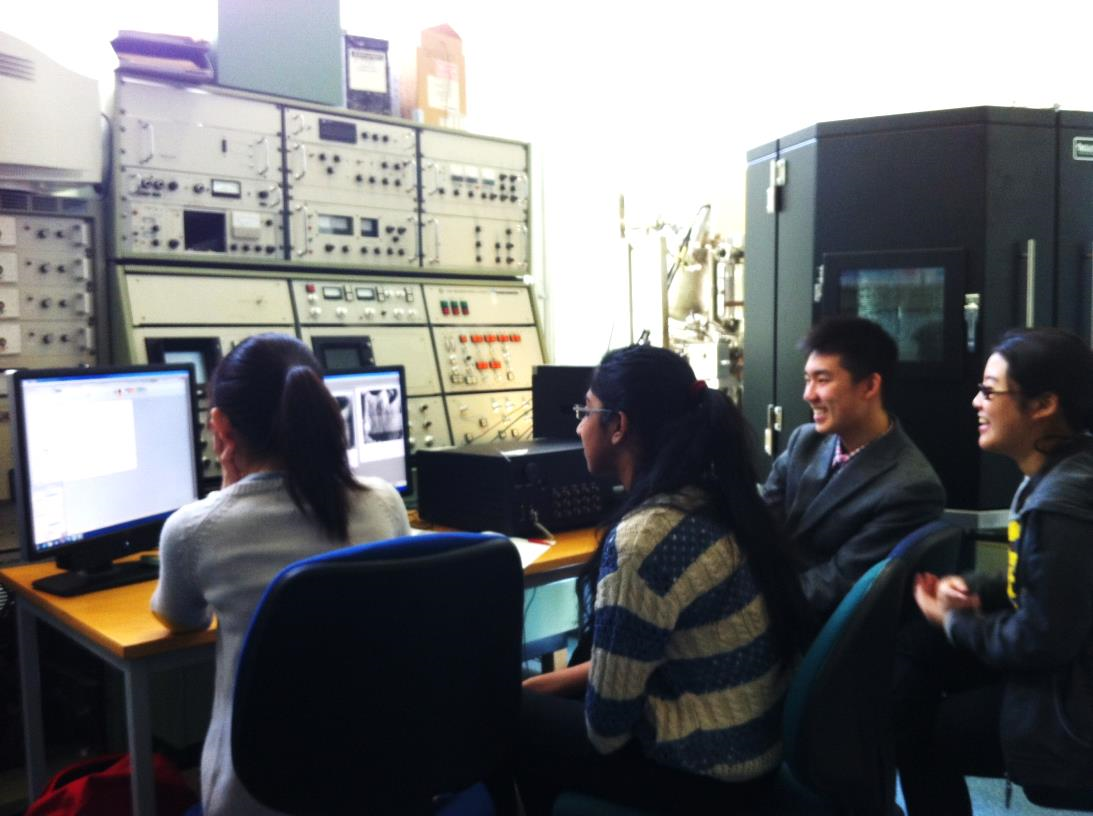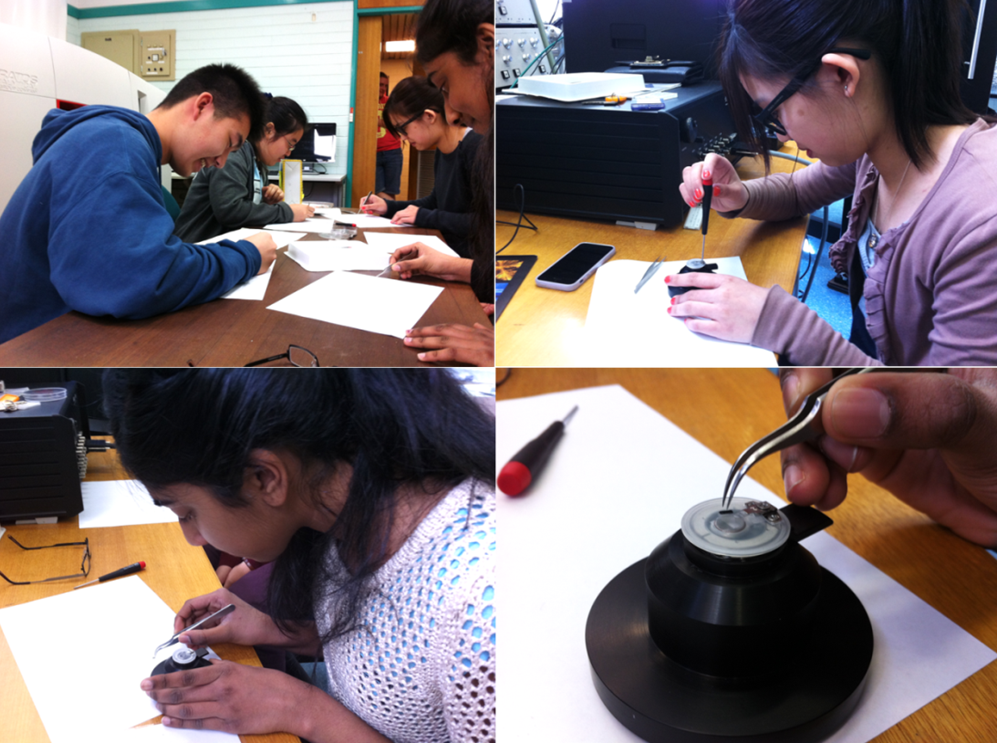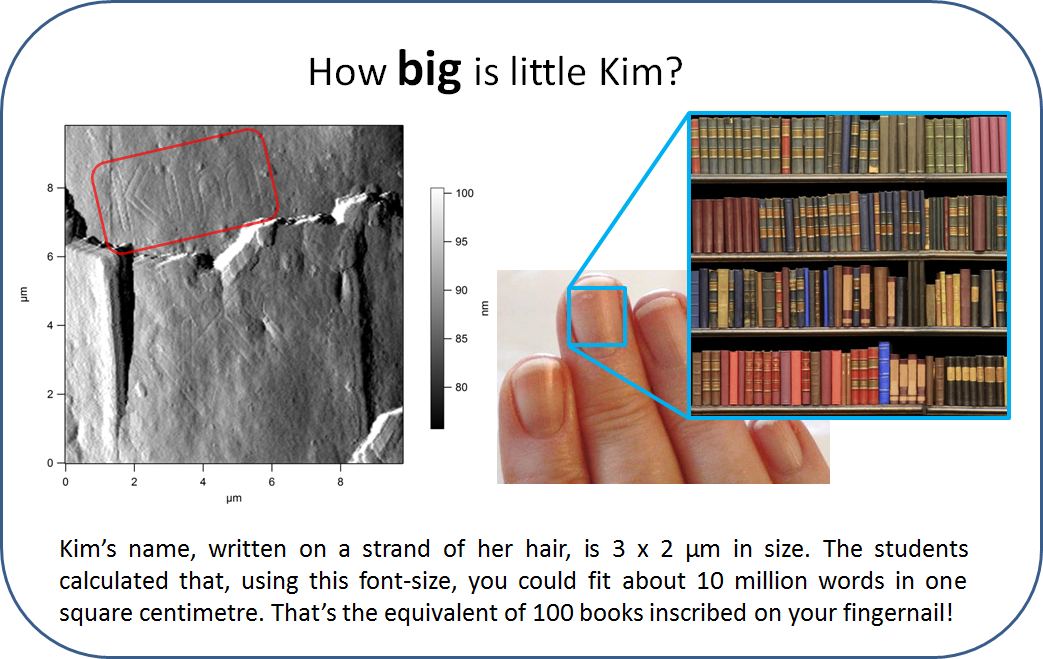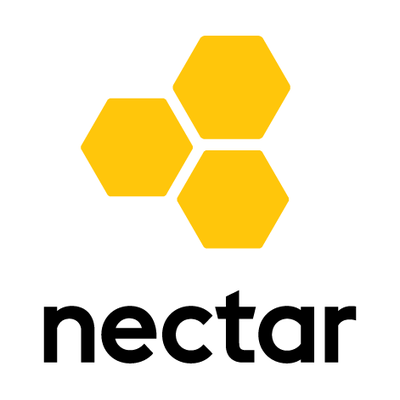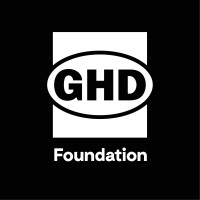December 2024: High school students in Perth, Western Australia learnt how humans can live on the moon in the SUPPORTING HUMAN HEALTH IN SPACE Education workshop
This month we saw the FARLabs team Dr David Hoxley, Dr Connie Darmanin and Dr Frazer Thorpe (Plants for space) head to Perth for the Asia-Pacific Regional Space Agency Forum (APRSAF-30), where they held a workshop in conjunction with Plants for Space at the University of Western Australia. DESA home schooled students joined counterparts from Joseph Banks College for the event which saw them learning about how to survive in space. From radiation and how to grow food to ensuring good mental health, the students learned key scientific concepts, conducted experiments, and finally, used what they had learned to design and build mini-moon bases. We got some fantastic results and very creative moon bases and Martian gardens. Congratulations to all those who attended!
Thanks to our funding bodies for making this possible.
# Telematics Trust Fund
# GHD foundation
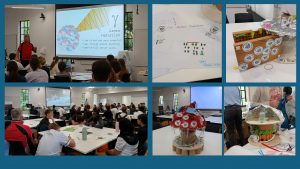 ”
”
“Students from Joseph Banks College and DESA home school group engaged in SUPPORTING HUMAN HEALTH IN SPACE lecture delivered by Dr David Hoxley and Dr Frazer Thrope. Final moon base structures of some of the students can be seen in this image, showing the students creativity!”
July – December 2024: The FARLabs team launched their Humans on the Moon challenge into Primary schools.
FARLabs took to a road trip to visit some primarys schools. First of was St Johns XXII in VIC followed by Dareton Primary School in NSW and then Gosnell Primary school in WA. During our visit, the students saw first-hand how to run a radiation equipment which they are controlling from their classrooms thousands of kilometres away. The students learnt about the moon and its environment, plants and radiation and then had lots of fun building a moon base and building in everything they need to survive on the moon.
Thanks to our funding bodies for making this possible
# Telematics Trust Fund,
# GHD foundation
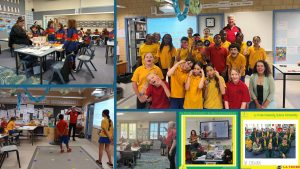
“Students from St Johns XXII (VIC), Gosnell (WA) and Dareton Primary School (NSW) engaging in the FARLabs Humans on the moon event. Dr David Hoxley and Dr Connie Darmanin ran the events with the students in their class room. We had lots of fun inspiring the students and listening to the fantastic ideas”
October 2013: High school students learn how to draw pictures on a strand of human hair
Can a year 11 student learn how to operate a half-million dollar scientific instrument in five days? This is the question we set out to answer with the FAR-Labs pilot visit. During school midterm, from the 30th September to the 4th October 2013, four Year 11 students from Penleigh and Essendon Grammar School visited the Department of Physics at La Trobe University. On Monday, the students were introduced to the Atomic Force Microscope, an instrument which takes images at nanoscale resolution by ‘feeling’ a surface using a tiny pointed stick. By Wednesday, they were operating the instrument independently, and using it to draw microscopic pictures on strands of their own hair.
“Being able to work with professionals and the AFM was truly an incredible experience… All in all, any science fanatic should get involved in this program!” Chloe
We began with an introduction to the Atomic Force Microscope (AFM). The AFM is an important instrument in nanoscience, because it allows us to visualize objects which are so small that they are literally ‘invisible’. Objects much smaller than the wavelength of visible light cannot be resolved with an optical microscope. Instead, AFM allows us to ‘feel’ their shape.
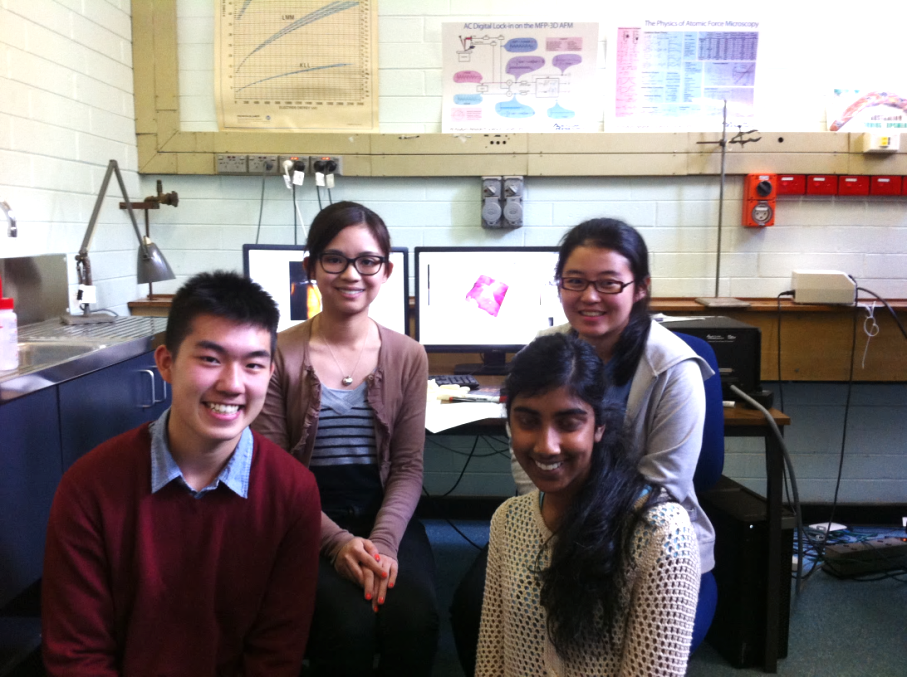
Meet the students. In the front sit Richi and Mahisha. In the back (left to right) are Chloe and Kim.
The next step for the students was to learn how to operate the AFM. They were trained in how to set-up the instrument and how to prepare sample in order to take high resolution images.
“We learnt about the procedures of loading and operating the AFM with the guidance of very helpful scientists, and really enjoyed working with this incredible microscope to do imaging and lithography on our hair samples. Not only did this project teach us a lot about the applications of the AFM, but it also allowed us to let out our inner creativity.” Mahisha
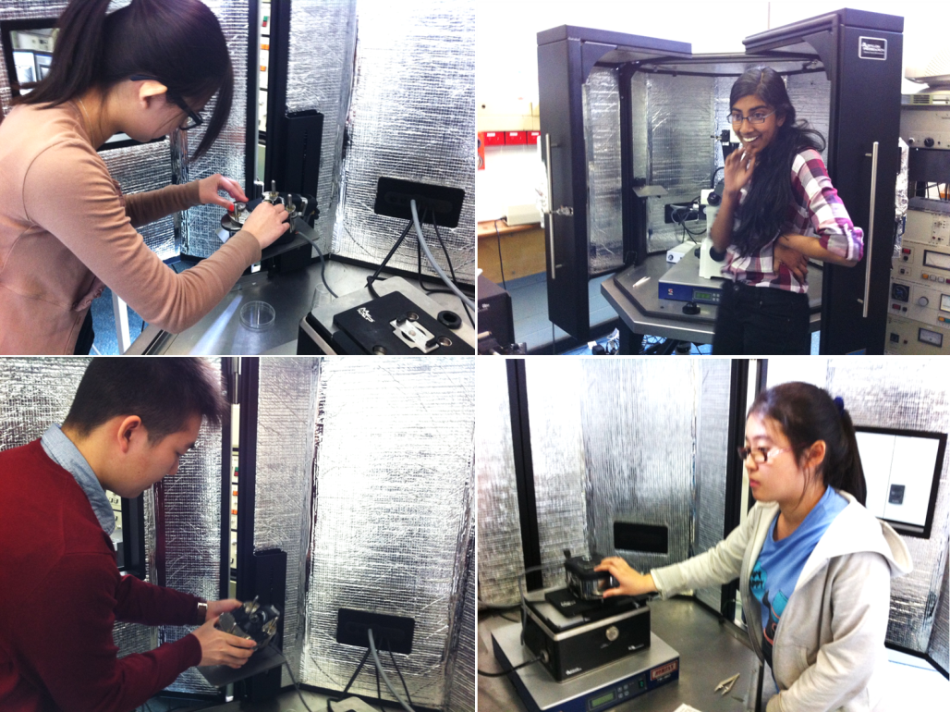
The AFM is the small metal box in Richi’s hands (bottom left). It is housed in an ‘isolation chamber’ to protect it from sound vibrations and electrical noise. Here the students are learning how to load the sample and how to focus on it.
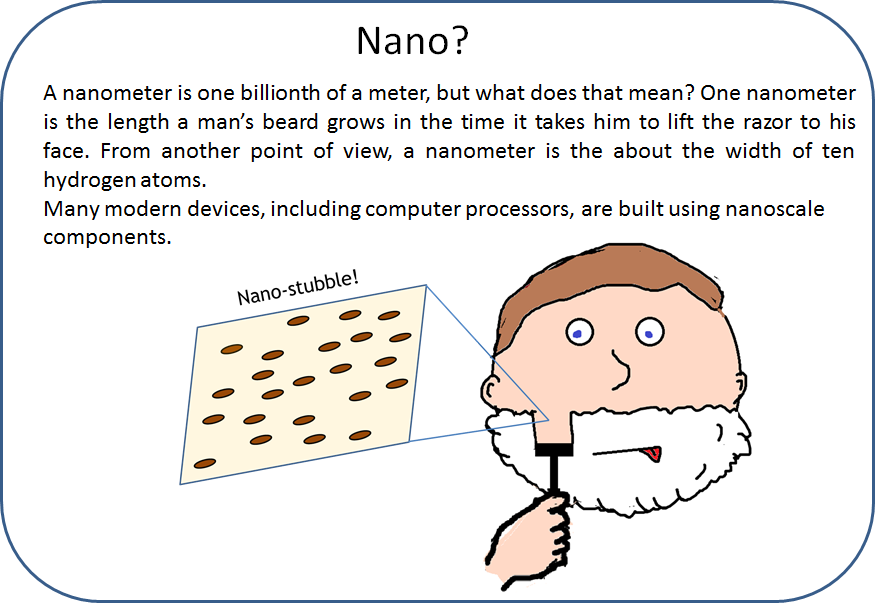 The students were shown how to take images of strands of their hair. They had to rapidly become comfortable with the operational software: learning how to optimise the feedback parameters to achieve high quality images. Besides hair, the students also took images of the microscopic bits on a CD stamp, and even of bacteria!
The students were shown how to take images of strands of their hair. They had to rapidly become comfortable with the operational software: learning how to optimise the feedback parameters to achieve high quality images. Besides hair, the students also took images of the microscopic bits on a CD stamp, and even of bacteria!
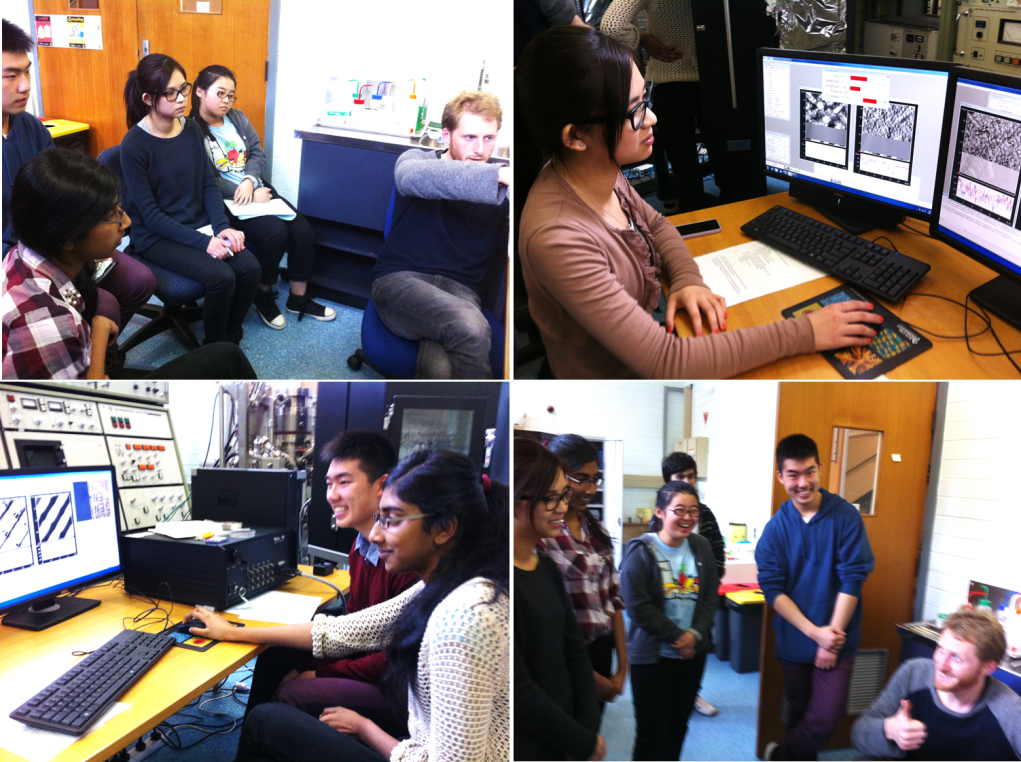
The students rapidly learned how to operate the expensive equipment. By day 3, they were working independently.
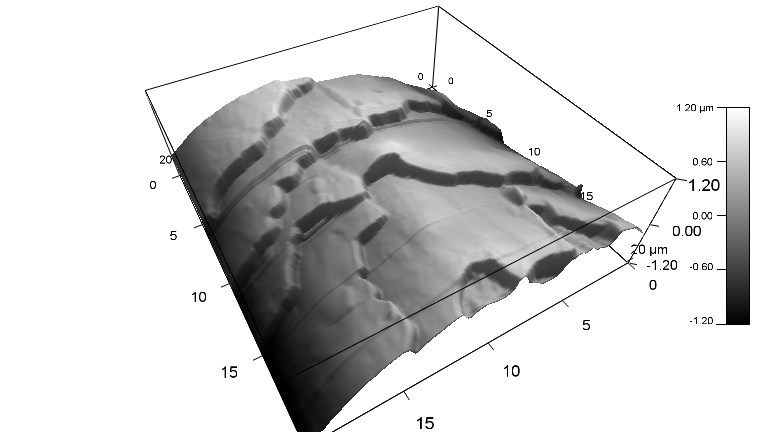
This is a 3D rendered AFM image of a strand of Chloe’s hair. The high resolution image reveals the overlapping plates (cuticles) which form the outer surface of the strand.
The students performed experiments to determine if it were possible to scratch images in the surface of human hair. They optimised the parameters for scratching, by systematically varying the applied force and the scratching speed and then observing the results. The optimum parameters were then used to define microscopic patterns of dolphins, owls, and the students’ names!
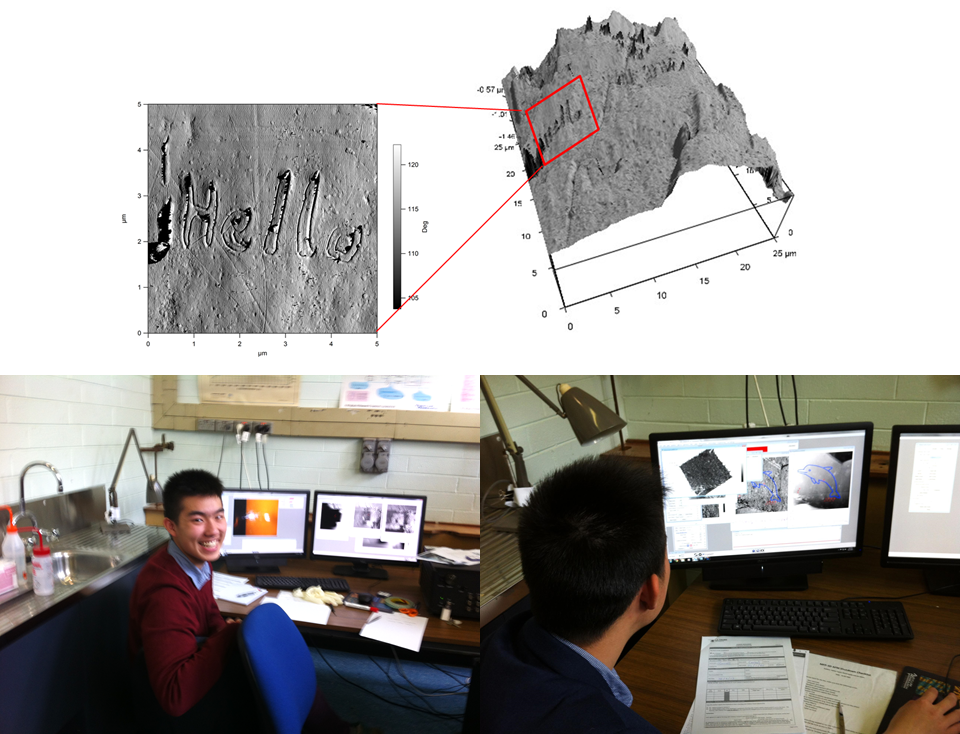
Top: the word ‘Hello’ written on a strand of Mahisha’s hair. Bottom: Richi is loading a picture of a dolphin into the lithography software of the AFM. He is about to use the AFM tip to scratch this pattern into a strand of his own hair.
“With the help of awesome scientists and expensive machines, we etched drawings of dolphins and moustaches into our hair. Pushing the boundaries of science and doing something probably no one has ever done before is by far the best way to spend a week of holidays.” Richi
Within days, the students were operating the instrumentation independently. They had acquired the skills to set-up the system, to load the sample of human hair, to focus on it, to take an image, to optimise the lithography parameters of controlled force and speed, to load a pattern into the lithography software, to draw that pattern and then to image the result. A productive week!
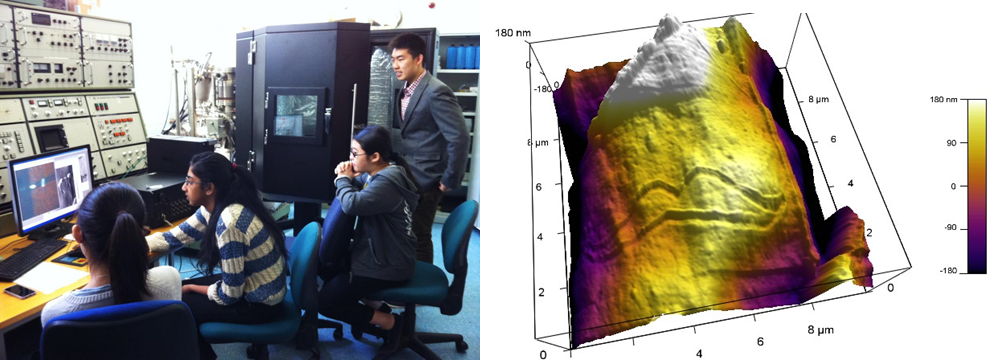
Left: The students had to work together to set up the instrument. Richi is aligning the laser onto the AFM cantilever, while Mahisha runs the computer software. Right: a moustache pattern created by the students measures about 7 µm across. That’s the size of a single red blood cell! Watch the webinar video where the kids will take you through the making of this mini-moustache!
“It was an amazing experience and we were able to learn new things and meet interesting people. Definitely recommended!” Kim
Watch the webinar video where the kids will take you through the making of a mini-moustache!
Thanks to our funding bodies for making this possible
# Telematics Trust Fund,
# GHD foundation

October 2013: High school students learn how to draw pictures on a strand of human hair
Can a year 11 student learn how to operate a half-million dollar scientific instrument in five days? This is the question we set out to answer with the FAR-Labs pilot visit. During school midterm, from the 30th September to the 4th October 2013, four Year 11 students from Penleigh and Essendon Grammar School visited the Department of Physics at La Trobe University. On Monday, the students were introduced to the Atomic Force Microscope, an instrument which takes images at nanoscale resolution by ‘feeling’ a surface using a tiny pointed stick. By Wednesday, they were operating the instrument independently, and using it to draw microscopic pictures on strands of their own hair.
“Being able to work with professionals and the AFM was truly an incredible experience… All in all, any science fanatic should get involved in this program!” Chloe
We began with an introduction to the Atomic Force Microscope (AFM). The AFM is an important instrument in nanoscience, because it allows us to visualize objects which are so small that they are literally ‘invisible’. Objects much smaller than the wavelength of visible light cannot be resolved with an optical microscope. Instead, AFM allows us to ‘feel’ their shape.

Meet the students. In the front sit Richi and Mahisha. In the back (left to right) are Chloe and Kim.
The next step for the students was to learn how to operate the AFM. They were trained in how to set-up the instrument and how to prepare sample in order to take high resolution images.
“We learnt about the procedures of loading and operating the AFM with the guidance of very helpful scientists, and really enjoyed working with this incredible microscope to do imaging and lithography on our hair samples. Not only did this project teach us a lot about the applications of the AFM, but it also allowed us to let out our inner creativity.” Mahisha

The AFM is the small metal box in Richi’s hands (bottom left). It is housed in an ‘isolation chamber’ to protect it from sound vibrations and electrical noise. Here the students are learning how to load the sample and how to focus on it.
 The students were shown how to take images of strands of their hair. They had to rapidly become comfortable with the operational software: learning how to optimise the feedback parameters to achieve high quality images. Besides hair, the students also took images of the microscopic bits on a CD stamp, and even of bacteria!
The students were shown how to take images of strands of their hair. They had to rapidly become comfortable with the operational software: learning how to optimise the feedback parameters to achieve high quality images. Besides hair, the students also took images of the microscopic bits on a CD stamp, and even of bacteria!

The students rapidly learned how to operate the expensive equipment. By day 3, they were working independently.

This is a 3D rendered AFM image of a strand of Chloe’s hair. The high resolution image reveals the overlapping plates (cuticles) which form the outer surface of the strand.
The students performed experiments to determine if it were possible to scratch images in the surface of human hair. They optimised the parameters for scratching, by systematically varying the applied force and the scratching speed and then observing the results. The optimum parameters were then used to define microscopic patterns of dolphins, owls, and the students’ names!

Top: the word ‘Hello’ written on a strand of Mahisha’s hair. Bottom: Richi is loading a picture of a dolphin into the lithography software of the AFM. He is about to use the AFM tip to scratch this pattern into a strand of his own hair.
“With the help of awesome scientists and expensive machines, we etched drawings of dolphins and moustaches into our hair. Pushing the boundaries of science and doing something probably no one has ever done before is by far the best way to spend a week of holidays.” Richi
Within days, the students were operating the instrumentation independently. They had acquired the skills to set-up the system, to load the sample of human hair, to focus on it, to take an image, to optimise the lithography parameters of controlled force and speed, to load a pattern into the lithography software, to draw that pattern and then to image the result. A productive week!

Left: The students had to work together to set up the instrument. Richi is aligning the laser onto the AFM cantilever, while Mahisha runs the computer software. Right: a moustache pattern created by the students measures about 7 µm across. That’s the size of a single red blood cell! Watch the webinar video where the kids will take you through the making of this mini-moustache!
“It was an amazing experience and we were able to learn new things and meet interesting people. Definitely recommended!” Kim
Watch the webinar video where the kids will take you through the making of a mini-moustache!

